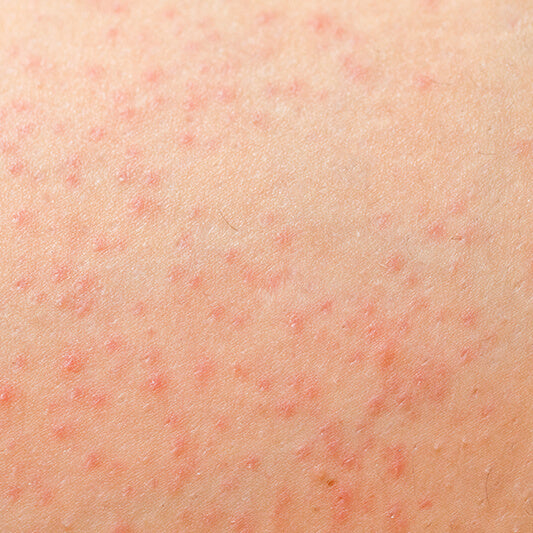
Is Fungal Acne Really Acne?
Spoiler alert: there’s no such thing as fungal acne. Fungal acne (aka folliculitis) is caused by an overgrowth of a yeast (Malassezia) — found naturally on the surface of your skin. The yeast feeds on sebum trapped within the pores. Here’s how to tell if your “acne” is actually a fungal infection, and what to do about it.
Published:
2 minute read
Spoiler alert: there’s no such thing as fungal acne. The term is a visual way to describe an infection of the hair follicles that causes acne-like bumps — but it’s technically not acne.
Instead of a bacterial infection, fungal acne is caused by an overgrowth of a yeast — known as Malassezia — found naturally on the surface of your skin. The yeast feeds on sebum trapped within the pores. The condition is sometimes called Pityrosporum folliculitis or Malassezia folliculitis.
Fungal acne is often misdiagnosed as acne vulgaris — so it’s probably more common than is documented. Here’s how to tell if your “acne” is actually a fungal infection, and what to do about it.

What causes fungal acne?
Typically, your skin is able to keep the Malassezia yeast under control — but it can flourish under certain conditions:
- Excessive moisture: humid weather, sweaty clothes, and tight-fitting clothing can encourage growth of the fungus.
- Medication: taking antibiotics can upset the balance of your skin’s microbiome, allowing fungus to flourish.
- Diet: processed foods high in sugar and carbohydrates promote yeast overgrowth.
- Immune deficiency: people with compromised immune systems are more susceptible to fungal acne.
What does fungal acne look like?
Because the pimples resemble whiteheads, folliculitis is often mistaken for bacterial acne. Here’s how to tell the difference between bacterial and fungal acne:
- Size: bumps are generally uniform in size and shape, without much variation.
- Itching: fungal acne often itches, whereas bacterial acne does not.
- Clusters: while bacterial acne pimples are often solitary, fungal acne often appears in group clusters.
- Color: fungal bumps are redder than typical comedonal acne.
How do you treat fungal acne?
Using traditional acne remedies like benzoyl peroxide to treat fungal acne won’t help. If you’re positive your acne is fungal (consult a dermatologist to be sure), there are several ways you can treat it:
- Lifestyle changes: showering more frequently and wearing loose-fitting clothes can help alleviate the problem.
- Dandruff shampoo: if your folliculitis is on the body, try using shampoo containing pyrithione zinc or selenium sulfide a few times per week as a body wash.
- Over-the-counter antifungal medication: athlete’s foot and jock itch creams and ointments containing antifungals like clotrimazole can also work for fungal acne.
- Prescription antifungal medication: if your fungal acne is persistent, your dermatologist can prescribe an oral antifungal medication like fluconazole.
How to prevent folliculitis
To keep fungal acne in check long term, follow these guidelines:
- Use dandruff shampoo as a body wash once a week or so.
- Eat a balanced diet that’s not too high in sugar and processed carbs.
- Shower daily, and after working out or sweating.
- Wear loose fitting clothing made of breathable fabrics like cotton
Dr. Lee’s last word
When treating acne — or any skin condition, it’s important to understand the cause. Our skin contains its own microbiome that exists in a delicate balance. While true acne is caused by an overgrowth of bacteria, I also see patients with acne-like breakouts triggered by yeast. It looks a little different, and should be suspected if your acne doesn’t resolve with regular treatments. The good news is that it’s very treatable once we identify it.
—Dr. Sandra Lee





